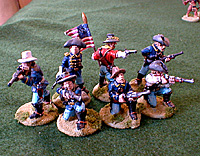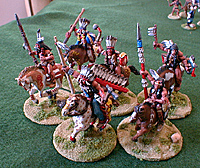
Historical Background
During the Civil War George Custer was one of the rising stars of the Union army. After that war ended he headed west to take command of the 7th cavalry. His scouts reported finding a large Indian village. Ignoring their warnings, he split his force into three columns. Custer rode into the valley of the Little Big Horn with about 200 men. None of them made it out alive. The Cheyenne and Sioux, outnumbering the troopers by at least 15-1, fulfilled Sitting Bull's prediction and wiped them out. The death of Custer, his two brothers and nephew, and 200+ troopers in a single engagement shocked the nation. The Plains Indians war would continue. The final chapter was written in 1890 at Wounded Knee.
After Action Reports
This battle was played with two different groups of middle school students.
Battle 1: As the Cheyenne warriors charged, Custer and his men retreated - right into the path of the Unkpapa. In a wild melee Custer was killed, and Chief Gall triumphantly paraded two captured guidons in front of his warriors. Only Capt. Keough survived this attack, killing Two Moon and escaping to the temporary safety of a nearby group of troopers. The remaining troopers formed themselves into a tight knot, determined to hold out as long as they could. At this point the Oglala seemed reluctant to engage in battle, and the troopers actually dared to counterattack them. But it was a futile effort, and soon their last stand was over. A decisive victory for the Indians.
 Battle 2: As this battle began Custer was astonished to see one of his Lieutenants
leading his troopers on the offensive against the Cheyenne and Oglala! It was madness,
and the Indians made short work of them. The Oglala captured two guidons. Meanwhile
in the north the Unkpapa reeled from the combined firepower of the troopers. After this
stinging blow the Unkpapa were seen skulking in the rear, much to the embarrassment of
their more courageous kin. A group of troopers tried to hide in a gully but were overrun
by the Cheyenne, with one Chief capturing a guidon. Soon the reckless Lieutenant's
entire force had been wiped out except for the bugler. Incredibly, the brave bugle boy
fought off a series of attacks before a volley of arrows killed him. The last stand was made
on a hill where the troopers were attacked from all sides. The Cheyenne Chief added to his
impressive list of achievements by capturing a second guidon and counting coup twice.
The Unkpapa Chief also found the courage to lead his band into the fight and captured
two guidons, including Custer's personal standard. It was another victory for the Indians.
Battle 2: As this battle began Custer was astonished to see one of his Lieutenants
leading his troopers on the offensive against the Cheyenne and Oglala! It was madness,
and the Indians made short work of them. The Oglala captured two guidons. Meanwhile
in the north the Unkpapa reeled from the combined firepower of the troopers. After this
stinging blow the Unkpapa were seen skulking in the rear, much to the embarrassment of
their more courageous kin. A group of troopers tried to hide in a gully but were overrun
by the Cheyenne, with one Chief capturing a guidon. Soon the reckless Lieutenant's
entire force had been wiped out except for the bugler. Incredibly, the brave bugle boy
fought off a series of attacks before a volley of arrows killed him. The last stand was made
on a hill where the troopers were attacked from all sides. The Cheyenne Chief added to his
impressive list of achievements by capturing a second guidon and counting coup twice.
The Unkpapa Chief also found the courage to lead his band into the fight and captured
two guidons, including Custer's personal standard. It was another victory for the Indians.
Objective: Since this is a one-sided battle the goal isn't simply to win. Instead, each player is competing against his teammates. The Indians are competing to see which war band can win the most honors; the cavalry are competing to see who can last the longest. Indians bands earn one victory point for each guidon they capture. Custer's guidon is worth two points. Indian chiefs also earn a victory point for their band for every coup counted. The band that earns the most points is the Indian winner. The Cavalry company that keeps its guidon the longest is the Cavalry winner.
Turn Sequence:
1. Cavalry move
2. Indians Move
3. Shooting (simultaneous, both sides)
4. Hand to Hand Combat
Cavalry and Indians Move: Foot figures may move up to 12". If they move more than 6", however, they may not fire during this turn. Mounted figures may move 24", but if the move more than 12" they may not fire this turn.
Shooting: All cavalry troopers have carbines and pistols. Only those Indians with bows or rifles may shoot. The range is unlimited. Roll 1D6 for each figure firing. Remove one enemy figure for every 6 rolled. The playing receiving the hits picks the figures to remove. If the target is less than 12" away then the Indians hit on a 5 or 6, the cavalry hits on a 4 - 6.
Hand-to-Hand Combat: The attacker matches his figures against his opponent's figures. However the guidon carrier may not be engaged unless all the other troopers in his group already have an opponent. Up to two figures may attack one enemy figure. Each rolls a die and adds any modifiers. High roll wins, and the loser is removed. If the roll is a tie, roll again.
H-to-H Die Roll Modifiers
Indians +1
Officer or Chief +1
On a Horse +1
Counting Coup: A chief that is in hand to hand combat may attempt to count coup. This must be declared before the dice are rolled. A chief that is counting coup forfeits all his Die roll bonuses. If the chief wins his opponent remains on the board, but his band earns one victory point. If he loses, he is a casualty.
Indian casualties: Indians that are hit are removed from the board and enter again next turn from their starting point. This is to represent additional Indians arriving from the village to join the battle. The first time a chief is hit he loses his horse, the second time he is hit he is removed from play permanently.
The Forces: Adjust the number of Indian and Cavalry groups to suit the number of players in your game. Just make sure there are plenty of Indians.
Indians: We played the game with six Indian bands representing the Northern and Southern Cheyenne, plus the Ogallala, Hunkpapa, Minneconjous, Brule, and Sans Arc Sioux. Each band had 10 - 12 warriors on foot and one mounted Chief. The warriors had a mix of bows, rifles, and melee weapons. A marker was placed along the board edge for each band to mark their entry point. The bands should be spread all around the board so that Indians are entering the board from all directions.
The Cavalry: Custer and a trooper holding his guidon were placed at the center of the board. Five Groups of 10-12 troopers were placed in random directions about 12" from Custer. These represent the surviving members of companies C, E, F, L and I. Each has a guidon and an officer.
The Board: The battlefield should include plenty of low hills. You can use felt to represent these if necessary.
Useful Resources:
Son of the Morning Star by Evan S. Connell
Killing Custer by James Welch
"Painting the Plains" by Mark Copplestone (http://www.wargamesfoundry.com/library/)
"Custer's Luck" by Mark Hannam, The Gauntlet #20
"Sioux Wars" by Pete Panzeri, After Action Review #2-8
The American Plains Indians, Osprey Men-at-Arms Series # 163 by Jason Hook & Richard Hook
Back to SJCW The Volunteer Summer 2001 Table of Contents
Back to SJCW The Volunteer List of Issues
Back to Master Magazine List
© Copyright 2001 by SJCW
This article appears in MagWeb (Magazine Web) on the Internet World Wide Web.
Other military history articles and gaming articles are available at http://www.magweb.com